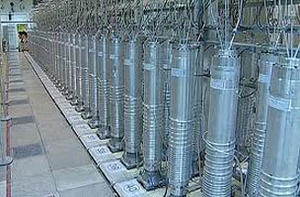IranNew proposals to Iran aim to slow down Iranian nuclear “breakout”
In two days of talks with Iranian representatives, the P5+1 powers offered Iran a new set of proposals which show a subtle shift in the powers’ position: rather than making it impossible for Iran to produce weapon-grade uranium – by shutting down the Fodro centrifuge farm and demand that Iran ship the uranium it has already enriched to 20 percent out of the country – the new proposals aim to make it more difficult, and slow, for Iran to develop weapon-grade uranium. The assumption undergirding the latest proposals is that if the process of producing weapon-grade uranium would be slowed down, it would be easier for Western intelligence services to discover it, and for military intervention to stop it, before a bomb is being produced.

Iranian uranium enrichment centrifuges // Source: bamdadkhabar.com
Two days of talks between Iran and the P5+1 group ended Wednesday with an agreement for technical experts from the two sides to meet in March and April, with the goal of the P5+1 powers remaining to constrain Iran’s stockpile of uranium enriched to 20 percent or more. Importantly, the six powers dropped an earlier demand: the shutting down of the Iran Fordo centrifuge farm, which is buried deep underground and which would thus be more difficult to destroy in an aerial attack.
The New York Times reports that it appears that the P5+1’s position has shifted from making it impossible for Iran to produce weapon-grade uranium – by shutting down Fodro and shipping the uranium Iran has already enriched to 20 percent out of the country – to trying to make it more difficult for Iran to develop weapon-grade uranium.
The latest proposals of the P5+1 to Iran thus focus on making it difficult for Iran to produce weapon-grade uranium quickly – with the assumption being that if the process of producing weapon-grade uranium would be slowed down, it would be easier for Western intelligence services to discover it, and for military intervention to stop it, before a bomb is being produced.
The six agreed that Iran could keep a small amount of 20 percent enriched uranium for use in a reactor to produce medical isotopes.
The two sides agreed that technical experts would meet to discuss the proposal, and Iran’s response to them, on 18 and 19 March in Istanbul, while the negotiations at this higher political level would resume in Almaty, Kazakhstan, on 5 and 6 April.
The Times notes that senior Western diplomats were not optimistic, saying that Iran had not in fact responded to the proposal of the six and that real bargaining had not yet begun. A senior American official told the Times that the meeting was “useful” — refusing to call it positive — and emphasized that it was “concrete results” that counted, not atmospherics.
European diplomats were even more skeptical, saying that the technical meeting was set to explain the proposal to the Iranians once again, and that Iran might come back in April with an unacceptable counterproposal that swallows the “carrots” of the six and demands more.
Informally, Western diplomats told the Times that the modified proposals to Iran included four main requirements Iran would have to meet before some of the economic sanctions on the country were relaxed:
- Iran should “significantly restrict” its accumulation of medium-enriched uranium – that is, 20 percent enriched. This uranium could be turned into bomb-grade uranium in weeks, not months, and Iran has been accumulating a growing stockpile of the material.
- Iran must suspend enrichment at Fordo, and accept restrictions which, one diplomat said, would “constrain [Iran’s] ability to quickly resume enrichment there.”
- Iran must dismantling part of the system that feeds low-enriched fuel into the Fodro plant’s centrifuges; if the feeding system were dismantled, it would take many week to rebuild it, thus giving Western intelligence services enough notice that Iran was reneging on the agreement.
- Iran must allow more regular, and more frequent, visits to its nuclear facilities by IAEA inspectors.
“What matters are concrete results on the most urgent issues, on 20 percent enrichment and on Fordo,” the American official told the Times, “the most destabilizing and urgent elements of Iran’s nuclear program.”
